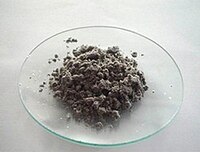
Photo from wikipedia
This short review describes the recent emergence of organosodium chemistry, motivated by the requirements of modern synthetic chemistry for sustainability, and powered by the use of sodium dispersion, a form… Click to show full abstract
This short review describes the recent emergence of organosodium chemistry, motivated by the requirements of modern synthetic chemistry for sustainability, and powered by the use of sodium dispersion, a form of sodium that is commercially available, easy to handle, and has a large active surface area. We present recent methods for the preparation of organosodium compounds using sodium dispersion, and their applications to synthesis. Sodium amides and phosphides are also briefly discussed.1 Introduction2 Sodium Dispersion3 Preparation of Organosodium Compounds3.1 Two-Electron Reduction of Aryl Halides3.2 Halogen–Sodium Exchange3.3 Directed Metalation3.4 Cleavage of C–C and C–Heteroatom Bonds4 Synthetic Applications4.1 Reduction in Combination with a Proton Source4.1.1 Bouveault–Blanc Reduction4.1.2 Birch Reduction4.1.3 Reductive Deuteration4.1.4 Chemoselective Cleavage of Amides and Nitriles4.2 Difunctionalization of Alkenes and Alkynes5 Sodium Amides and Phosphides6 Conclusions and Outlook
Journal Title: Synthesis
Year Published: 2021
Link to full text (if available)
Share on Social Media: Sign Up to like & get
recommendations!